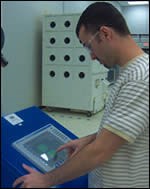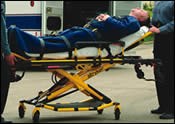Powder Coating Rx
How Stryker Medical responded to its own manufacturing emergency...
You can’t always get what you want, the Rolling Stones once sang.
Sometimes, though, you can.
Case in point: the powder coating line at Stryker Medical’s new plant in Kalamazoo, MI.
Nearly 750 workers at the 436,000-sq-ft-plant use turret presses, lasers, CNC tube benders and CNC machining processes to convert sheet metal and tubing into components for patient transfer equipment used in hospitals and emergency medical service (EMS) units. Among the products manufactured at Kalamazoo is the Power-Pro powered ambulance cot, which uses a battery-powered hydraulic system to let technicians raise and lower patients at the touch of a button.
“The biggest problem for our EMS customers is back injuries,” explains Senior Principal Engineer Dean Birkmeier. “This system is almost all-aluminum to reduce weight. It runs off a 24-V battery system used to power a cordless drill.” According to Stryker, the hydraulic system can save EMS technicians from lifting as much as 3,000 lb/shift.
Focus on Ergonomics
Safety and ergonomic issues are what drove Stryker product designers to develop the Power-Pro unit. And, aside from addressing the capacity and operating constraints associated with the old line, ergonomics were the prime consideration in design and development of the company’s new powder coating line.
“We were handcuffed by our old system,” Birkmeier recalls. “It didn’t have the capacity we needed as our business grew. The pretreatment system was carbon steel. We were running it 24/7 for more than four years. But the big thing was the old application system. We had a lot less control than we have now.” The old line ran at speed of six ft/min, and total cycle time was two hr 20 min, he adds.
But lack of capacity and maintenance issues weren’t the only problems with the old line. “Inclines and declines were much steeper than normal—it was a high-G roller coaster,” says Powder Coat Technician Treavor Rines. “The new line includes incremental increases in height at load and unload areas. The different areas let operators load a variety of parts without a lot of bending or lifting over their heads.”
User-friendliness also extends to the new line’s twin spray booths, according to Birkmeier. “In our old booth, operators would stand across from each other and basically just pelt each other all day,” he recalls. “Now, we’re essentially spraying into filter banks. One operator sprays into a bank, the other faces the other way and sprays into another bank. We also lowered the noise level in the application area below 80 dB, so we don’t have hearing protection issues, we don’t have respirators, we don’t have any of that stuff.”
Every Color, Every Hour
Supplied by Wagner Industrial Solutions (Carol Stream, IL), the spray system features two booths and a quick-change powder feed system. The powder feed center is important, because Stryker sprays six primary colors—yellow, black, textured black, red, gray and opal. Yellow is the Stryker color for EMS units; other colors are intended to blend in more in hospital settings.
“The primary colors we paint are opal and gray,” Rines says. “Those are reclaimed. Other colors are spray-to-waste, because we spray them basically on-demand. When our customers need one of those colors, we’ll fit it on one of the lines spraying opal or gray at the time.”
“I think of it as one spray system but with two booths,” Birkmeier explains. “We have two operators, two booths, and one spray system controlled by a powder feed center. Everything we manufacture here goes through the system, and we promised our customers—our assembly and fabrication teams—every color every hour. We’re certainly able to do that even though we don’t do it right now.” Because assembly teams still operate on a batch system, color changes don’t occur that frequently, he explains.
Birkmeier foresees that Stryker’s powder coat team will eventually make use of the quick-change capability. “Right now, it can be as fast as a couple minutes to change over,” he says. “If we want to reclaim, it’s maybe 10 minutes. But if we truly move to a paint-on-demand system, it’s just not going to be worth 10 minutes of time.” He also anticipates spraying a wider range of colors in the future.
System Details
The washer, dryer, conveyor, ovens and control software for the system were supplied by Midwest Finishing Systems, Inc. (Mishawaka, IN). According to Birkmeier, the choice of system integrators was the result of a fairly extensive selection process.
“We sent out packages for quotes and did full-fledged evaluations on three other system suppliers,” he says. “Midwest was best in technology and delivery, and we felt their company was similar to Stryker in its business philosophy and culture.”
Delivery was a key issue, Birkmeier adds, because having the powder coat system up and running was actually the prerequisite for other departments to move into the new plant. “The powder equipment came in very early in plant construction,” he recalls. “We brought very little from the old plant here, and we actually built the walls around most of the system. The first concrete flooring poured in the plant was in the powder area, so we could start bringing equipment in.”
Pretreatment is a five-stage process consisting of an alkaline cleaner, rinse, iron phosphate, rinse and sealer. Because of the hardness of city water in Kalamazoo, all rinses and a final halo use reverse osmosis (RO) water. The system runs at 140°F, and is followed by a five-minute trip through a dry-off oven at 425°F.
The emphasis on operator friendliness continues in the pretreatment area with automatic transfer of pretreatment chemicals. “Our suppliers pump chemicals directly out of their totes into our bulk tank system,” Rines explains. “It pretty much eliminates handling of chemicals by any of our employees.
“From the bulk tanks, we have two options: a continuous-feed system, or, if we dump and recharge, there’s a push-button system based on the charging recommendations for that tank,” he continues.
The conveyor features load bars that facilitate hanging and allow operators to hang a part every two inches. “The load bar system really opened up the door for us to have the same density but without needing to stop the line,” Rines explains. “In the old system, we’d have to stop the line to paint a really dense rack. Now, the line runs at a pretty constant speed. If there’s an issue with the time needed to spray, we’ll create space. We’d rather have gaps than line stoppages.” Some small parts are still racked; this happens off-line, he adds.
All told, the line handles more than 6,000 active part numbers, plus service parts—more than 234,000 individual parts in a recent month, Rines says. All parts, whether steel or aluminum, receive the same TGIC powder finish.
After powder application, parts cycle through the curing process in only 17 minutes at 375–410°F. Stryker technicians look for film builds of 2–5 mils. “That’s based strictly on part geometry issues,” Birkmeier says. “Our design-for-manufacturing people like to combine parts to minimize assembly complexity. That creates challenges for us to get into corners and crevices.”
Process Control and Management
Overall system control is via a PLC-based system with control software supplied by Midwest. It features touch-screen operator interface and remote support and maintenance capabilities.
A detailed line control plan developed by managers and operators provides the blueprint for day-to-day operation. “The line control plan covers every parameter, and lists critical criteria and what’s acceptable,” Birkmeier explains. “For example, in the pretreatment system we check and record temperatures, pressures, concentration, pH in some stages, conductivities, chemical levels, pump settings, etc. on a regular basis.
“Each parameter has an acceptable range of operation, and each control chart has typically five bands: a white band, upper and lower yellow band, and upper and lower red bands,” he continues. “If it’s operating in the white zone, you don’t do anything. We call the yellow bands the reaction zones—when it gets to yellow, the plan gives you a list of procedures to get it back into the white. We hope we don’t get to the red zones, and it’s extremely rare. But if we do, we have a specific check list of instructions to get the problem resolved.”
The plant is ISO 9000 accredited. But, because it produces medical equipment, it’s also subject to regulation by the U.S. Food and Drug Administration (FDA). “Both systems want to know that you’re using good manufacturing processes, that you have quality systems in place, and that you’re adhering to them,” Birkmeier explains.
The new line runs at speed of 12 ft/min, and with twin spray booths capacity is essentially quadruple that of the previous system. “We’ve gone from seven days a week, 24 hrs a day on the old line to pretty much one-and-a-half shifts on this one,” Birkmeier says. “The first shift runs both booths, and on the second shift one operator will bounce back and forth from booth to booth to pick up odds and ends based on customer needs.”
Right now, the system has plenty of capacity to feed Stryker’s assembly teams—something that has required a change in mindset for some operators. “If you put stuff on the line, people want to pound it through whether the customer needs it or not,” Rines says. “It’s human nature. We’re trying to train them to stop over-producing and push everything back upstream as far as we can. When you have a capacity issue like we did before and you have to run seven days a week, there’s no such thing as overproducing. So that was a big switch in thinking.”
Maintenance on the old system took place during color changes or on weekends, according to Rines. “But what we do a lot of that on second shift now, and all the third shift does is scheduled maintenance,” he says.
Birkmeier and Rines agree that the most important thing about Stryker’s new powder coat system is that it was developed for and focused on the people who operate it as well as downstream customers. “System design was a team effort using the people who work on the line very day,” Birkmeier says. “They’re the people who deal with the problems, and they know the solutions.”
Related Content
Masking Solutions for Diverse Applications
Global Mask of Barcelona, Spain showcases its solutions at Paint Expo 2024 in Germany.
Read MoreCan You Afford to Not Use Custom Masking?
Are you weighing the costs of a custom masking solution vs. an off-the-shelf solution? Christy Schulthess of Custom Fabricating & Supplies discusses the overall savings that can be realized with custom masking.
Read MoreTop Shop Builds Original Systems for Coating Medical Devices
Engineers at Surgical Coatings in Colorado have been ingeniously developing their own equipment, automation, processes and software since this powder coater’s inception in 1995.
Read MoreEPSI Relaunches Custom Masking Program
EPSI’s plotter cutting provides custom solutions for complicated masks and irregular shapes.
Read MoreRead Next
Education Bringing Cleaning to Machining
Debuting new speakers and cleaning technology content during this half-day workshop co-located with IMTS 2024.
Read MoreDelivering Increased Benefits to Greenhouse Films
Baystar's Borstar technology is helping customers deliver better, more reliable production methods to greenhouse agriculture.
Read MoreEpisode 45: An Interview with Chandler Mancuso, MacDermid Envio Solutions
Chandler Mancuso, technical director with MacDermid Envio discusses updating your wastewater treatment system and implementing materials recycling solutions to increase efficiencies, control costs and reduce environmental impact.
Read More

























